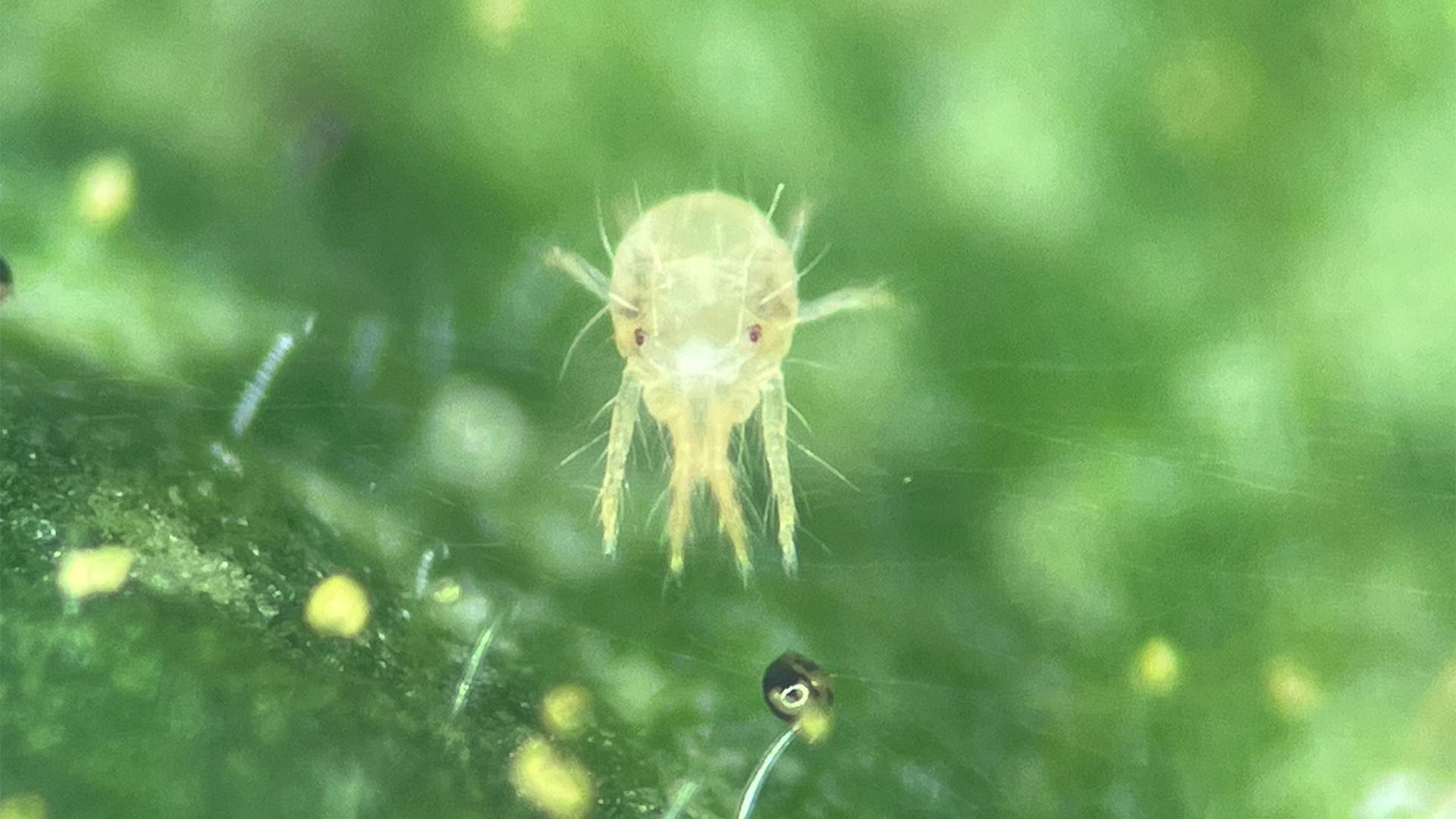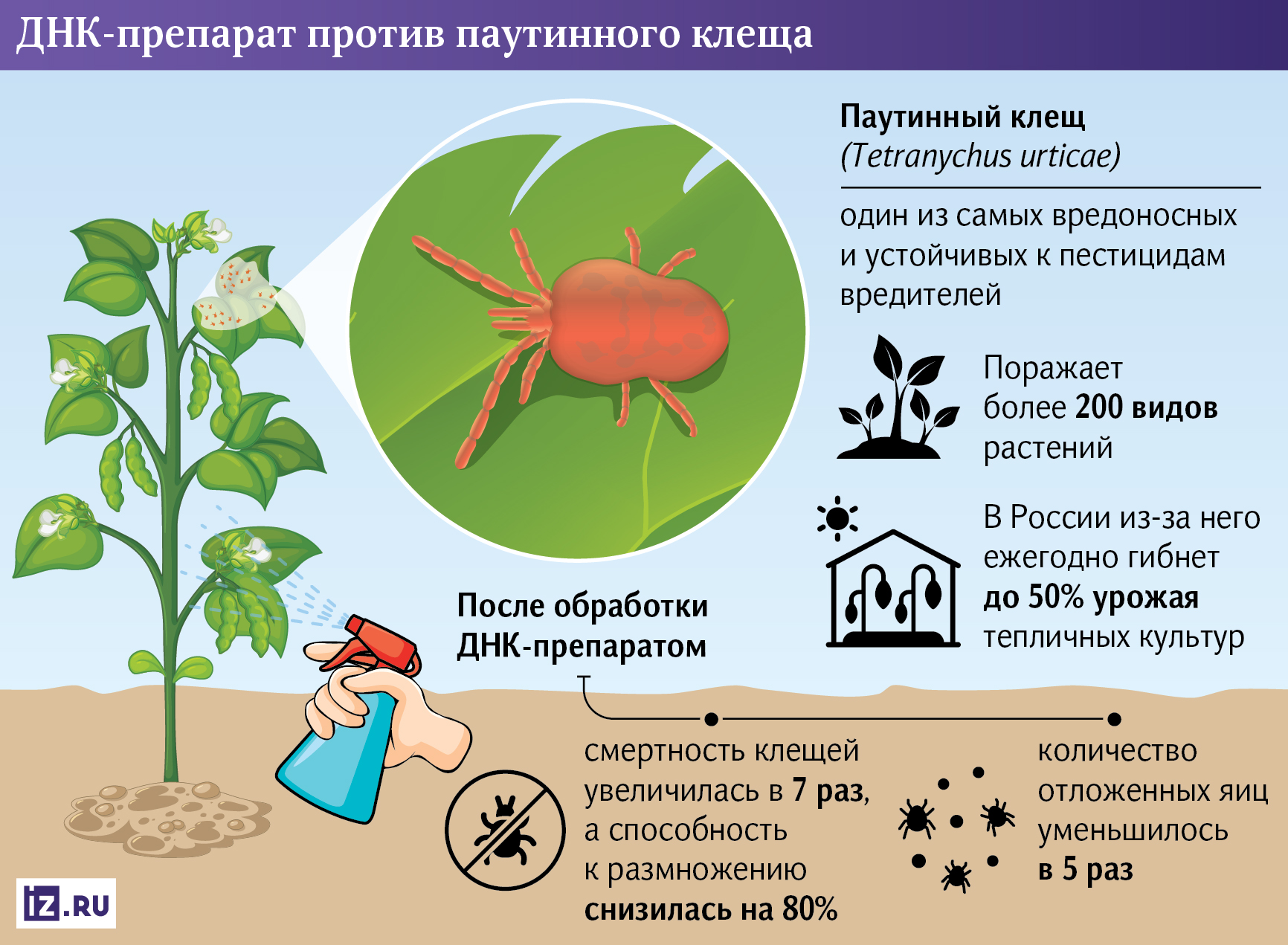- Статьи
- Science and technology
- Agrarian evolution: DNA drug will destroy the main enemy of greenhouse crops
Agrarian evolution: DNA drug will destroy the main enemy of greenhouse crops

Scientists have developed a combined drug based on DNA technologies that reduces the number of spider mites by seven times, reduces its reproduction by 80% and does not pollute the environment. This small arthropod affects more than 200 plant species, leading to their wilting, so the proposed method will help protect greenhouse vegetables, field crops, garden and ornamental plants. According to research, it kills up to 50% of greenhouse crops in Russia every year. For more information about the breakthrough development of farmers, see the Izvestia article.
What is the danger of a spider mite?
Novosibirsk State Agrarian University and Vernadsky Crimean Federal University have developed an environmentally friendly agent against spider mites that combines fungi and DNA acaricides. These are short DNA molecules (oligonucleotides) that enter the body of pests and inhibit the work of key genes responsible for protecting the body from toxins and infections.
The spider mite (Tetranychus urticae) is one of the most harmful and resistant to pesticides. It affects more than 200 plant species, including agricultural crops and ornamental flowers. As the developers told Izvestia, in Russia, up to 50% of the greenhouse crop perishes annually.
The ability of the spider mite to adapt to chemical pesticides due to its short life cycle and high reproduction rate makes traditional plant protection products less effective. Therefore, in agriculture, new drugs are needed to control the number of pests that will allow it to be controlled and at the same time will not damage the environment, unlike existing drugs that can pollute soil and water.
To enhance the effect, the researchers added the pest-threatening fungus Metarhizium robertsii to the DNA acaricide, which secretes enzymes that damage the mite's defenses, thereby weakening it. This facilitates the penetration of DNA acaricide into the body.
The authors tested the combined drug by applying it as a solution to bean leaves with pests. The effectiveness of the drug was assessed after six days by the death rate of ticks and the number of eggs laid. The experiment showed that the fungus Metarhizium robertsii reduces the number of ticks by 4.5 times, and the DNA acaricide by 3.3 times. At the same time, combined use increased tick mortality by seven times and reduced their ability to reproduce by 80%, and the number of eggs laid decreased by five times.
DNA acaricides in combination with fungi are safe for the environment, decompose quickly and do not harm beneficial insects. Therefore, the proposed approach can be used to protect a wide range of crops, especially from chemical-resistant pests.
— Our development opens a new biorational way for plant protection. We have demonstrated for the first time that a combination of antisense oligonucleotides and a fungus can effectively control dangerous pests such as spider mites. In the future, we plan to adapt the method for other pests by studying its effect at various stages of their life cycle," said Ivan Dubovsky, head of the Research Center for Biological Protection of Plants at Novosibirsk State Agrarian University, head of the project supported by a grant from the Russian National Science Foundation.
How to destroy pests
Global climate change is leading to the fact that some species of organisms are rapidly seizing new ecological niches. There are also very harmful insects that can infect millions of hectares of forest in one season. Combating them is a very urgent task, said Igor Shkradyuk, coordinator of the industrial greening program at the Wildlife Conservation Center.
"Only practice will show how effective the new tool will be," the specialist emphasized.
The spider mite is one of the most dangerous plant pests in greenhouses and outdoors in the warm and dry climate zone (Southern Russia, the Volga region), and its damage will increase in the coming years due to global climate change. The common spider mite is widespread all over the world, except Antarctica, Alexander Ignatov, professor of the Department of Agrobiotechnology at the RUDN Agricultural Institute of Technology, told Izvestia. The problem is exacerbated by the biological characteristics of the arthropod - it reproduces rapidly (a new generation can reproduce as early as 5-20 days after laying eggs) and adapts very quickly to chemical plant protection products.
— I have been familiar with the use of DNA insecticides in plant protection for a long time. First, scientists at Vernadsky Crimean Federal University found an effective combination of DNA pesticides with viruses that infect insect pests and insect vectors of human diseases. Now they have taken a new step forward and received an effective means of combating a new group of phytophages — spider mites. Of course, there are still questions about the mechanism of joint action of the fungus and DNA acaricide," said the professor.
According to the scientist, Metarhizium fungi are pathogenic to ticks and insect pests of various plants. They are often found in high concentrations in the soil.
— Biologics for agricultural pest control have been developed based on various types of Metarhizium. However, the interaction of different types of these fungi with plants and other drugs is still poorly understood. Scientists at the University of Maryland (USA) have discovered that Metarhizium species have different strategies for attacking plant pests, and, in particular, the M. robertsii species (used by our scientists) kills the victim with toxins. Overall, the development is very promising," said the researcher.
The results of the study are published in the Journal of Invert Pathology.
Переведено сервисом «Яндекс Переводчик»






